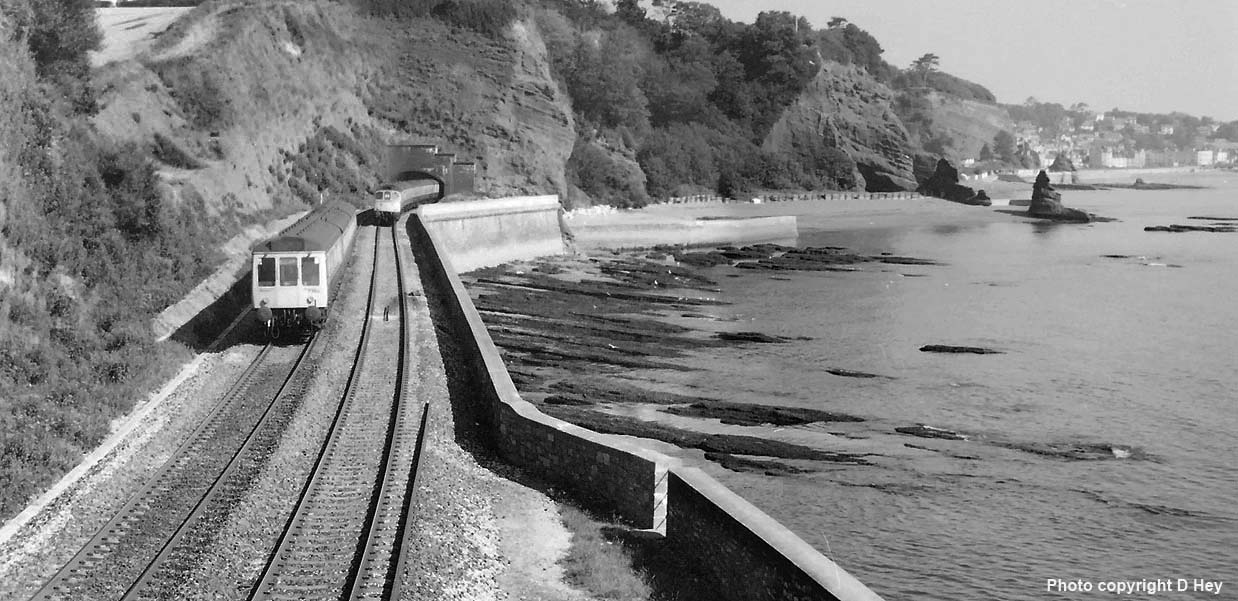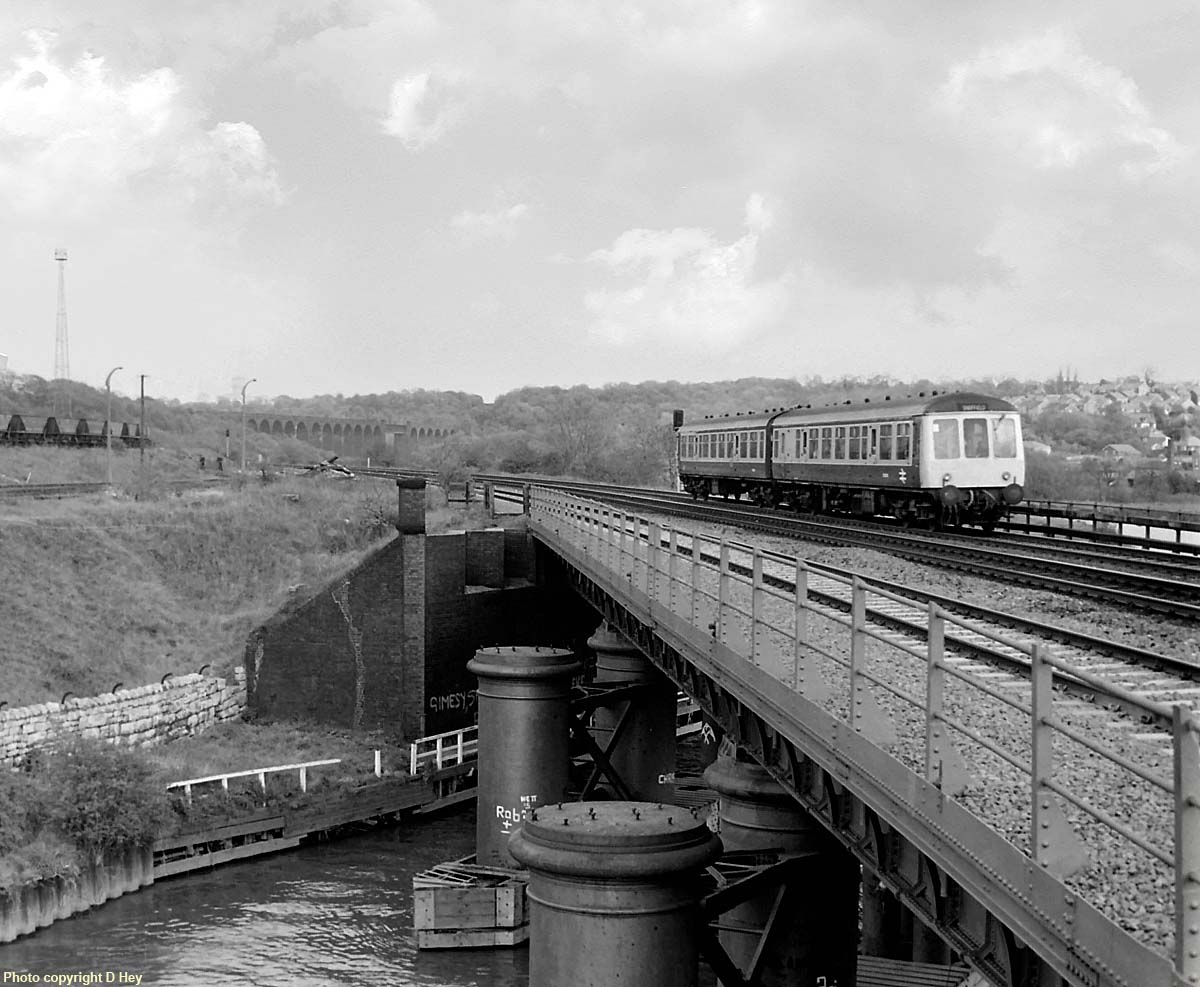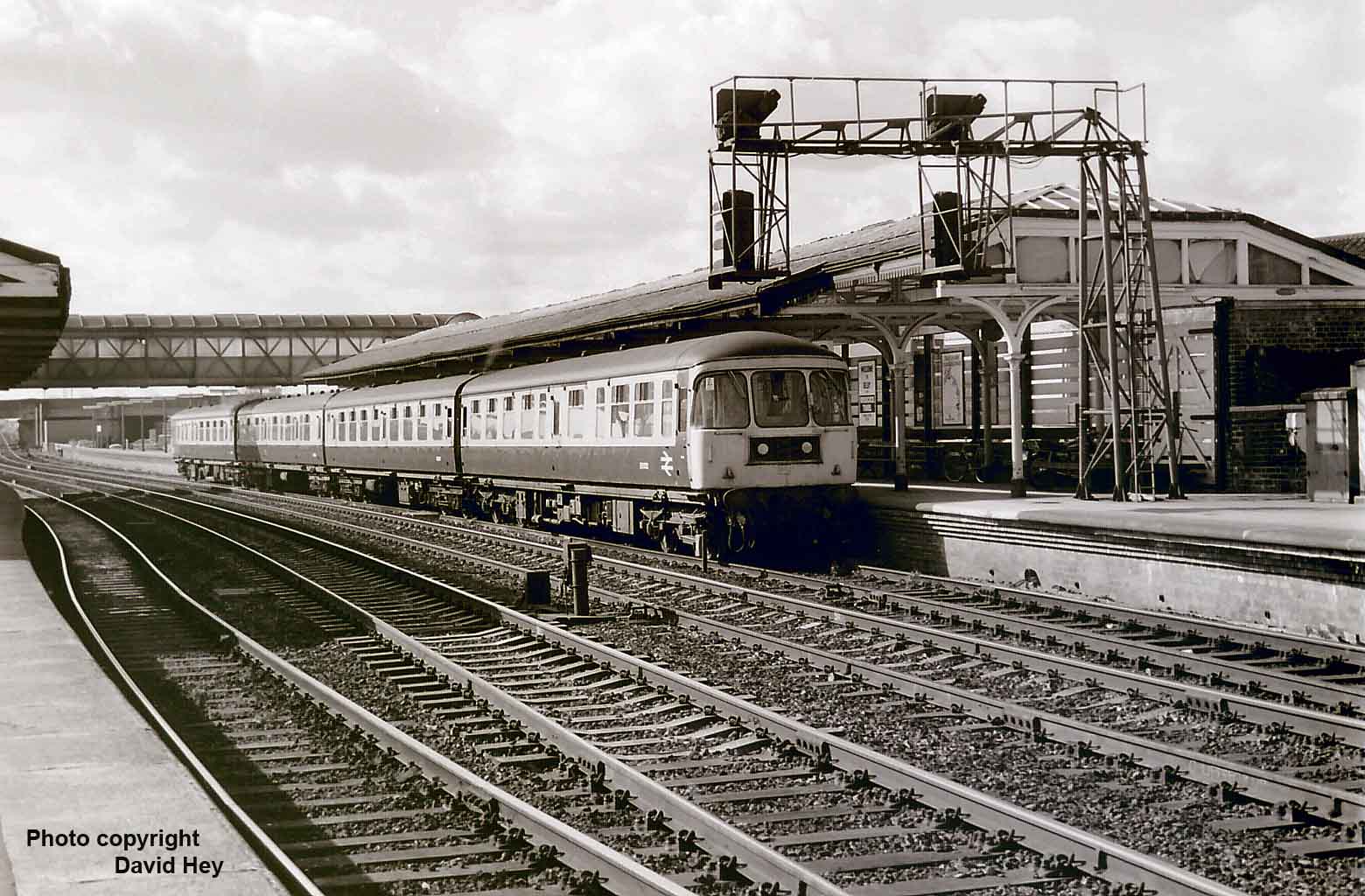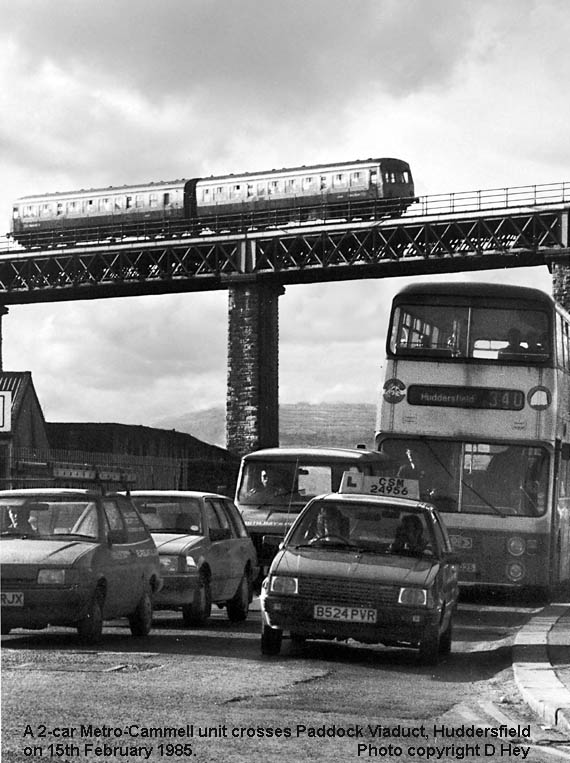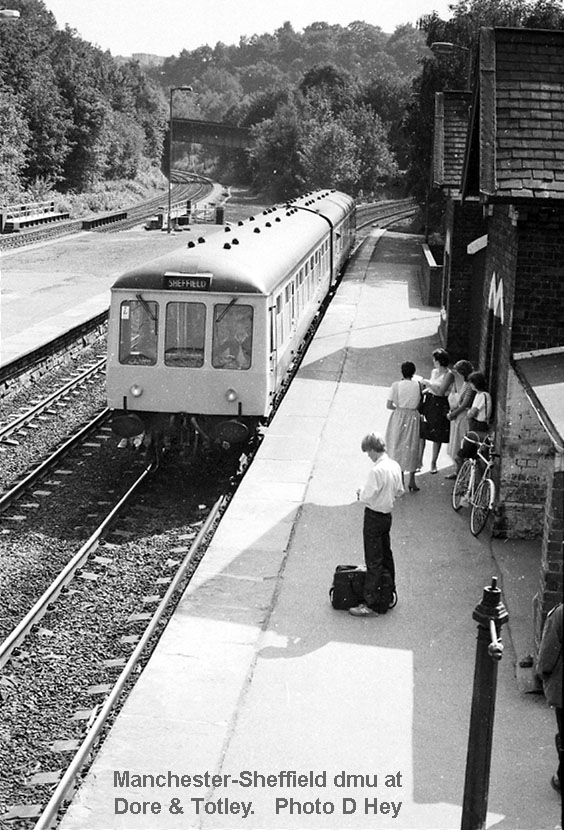With the ageing process creeping up with a vengeance, never a day goes by that I haven't wanted to photograph Sixties steam all over again. Only there's a catch. Who in their right mind would want to put themselves through the ordeal of steam's demise for the sake of a few memories? After all, nostalgia is a futile diversion - and often mistaken - for we kid ourselves into believing that the past is somehow better than it is today. It isn't always, of course, and nothing is more likely to cure an old fool of a yearning for going backwards than witnessing the demise of steam a second time around. Well, the same can be said of the first-generation diesel fleet (including diesel railcars) hence the reason for photographing the rank and file of BR's elderly fleet of DMUs before they vanished from scene at the end of the 1980s.
DIESEL MULTIPLE UNITS IN DEVON
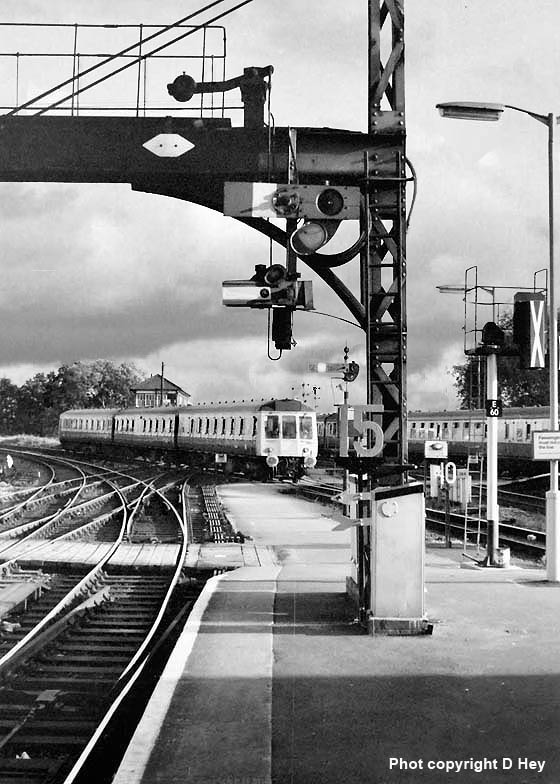
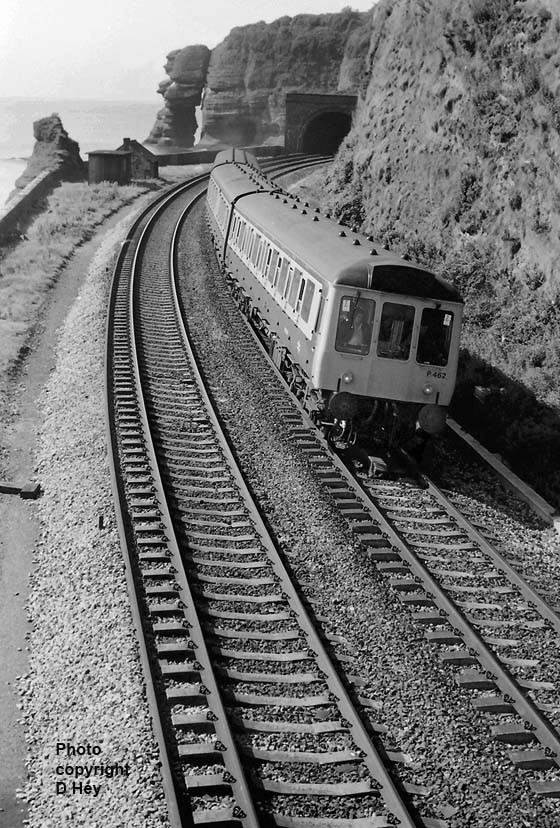
(Above-Below) a 3-car Class 117 emerging from Parsons Tunnel with a local service to Exeter on 24th July 1984 and returning on the same day. The generously-glazed first-generation DMUs provided passengers with by far the best views the South Devon coastline
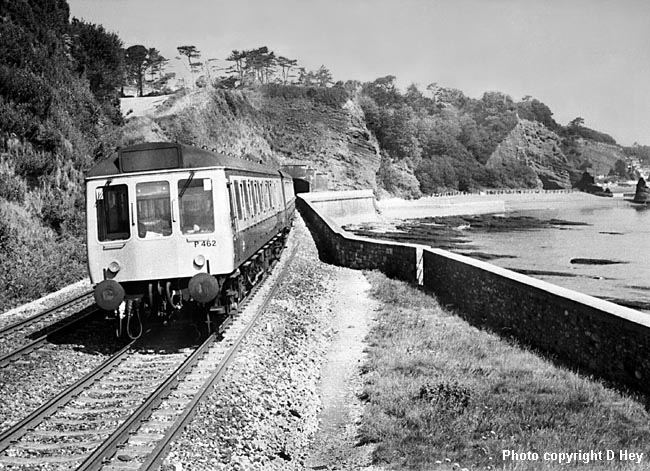

(Above-Below) Prior to nationalisation in 1948, the 'Big Four' railway companies commissioned a number of artists, including members of the Royal Academy, to produce artwork for railway travel posters. The companies were keen to promote the most beautiful parts of the country through which their lines served, and in particular the GWR wasted no time in publicizing the holiday destinations in the West Country. Indeed during the inter-war years the popularity of many Devon and Cornish resorts was largely due to the enterprise of the GWR's publicity machine. For example, the 'Cornish Riviera' was promoted intensively not only in the UK but also in the USA, including this fine study by Murray Seccretan of 'King' class heading a wetbound express in 1935. The NMSI Collections Online is a superb website which displays more than 230,000 objects including a range of railway travel posters A word of helpful advice when viewing these images. Press F11 on the keyboard to empty the screen of all extraneous clutter (tool bars top-bottom etc) revealing a full-size webpage on screen...it really does make a difference! After viewing super-wide size, move cursor off the image and right-click to return 'back' to the page. You can press F11 on the keyboard at any time to return to the original screen...a visit is highly recommended. (Below) Super-wide image of a Class 117 unit about to eclipse Class 33 No 33009 heading a down train. Click on photo once, then again to see full-sized images.
TEESSIDE
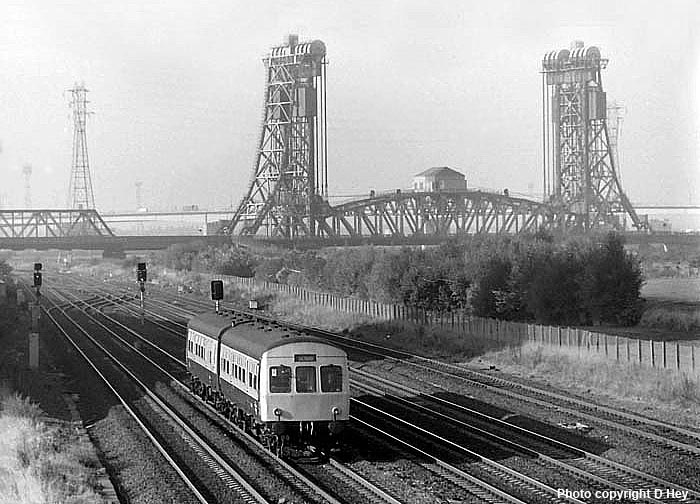
(Above-Below) This 2-car Metro-Cam unit heading towards Middlesbrough on 25th September 1986 is dwarfed by the Tees Vertical Lift Bridge, a massive structure that dominates the landscape. Opened in February 1934, the builders opted for this unusual design due to the low height of the Tees' riverbank. A conventional bridge would have required two lengthy approach roads in order to gain the necessary height to clear shipping passing up the river to Stockton. The bridge carries a single carriageway on the A1032 road linking Middlesbrough and Billingham, and has a vertical lifting span (counterbalanced by weights) which can be seen for miles around. However, since the decline of the number of ships using Stockton's port the lifting operation was no longer required and the deck was bolted down after its final lift in 1990. Behind it is the road viaduct completed in 1975, which forms part of the A19 trunk road from Thirsk in the south to the Tyne Tunnel and Sunderland. The bridge provides a vantage point for the telephoto shots of Tees Yard on the 'BR North Eastern Region' page, along with this one looking across the river towards Billingham as a 2-car unit heads to Middlesbrough. The A19 viaduct is the longest on the Tees with 68 spans and carries four lanes of traffic.
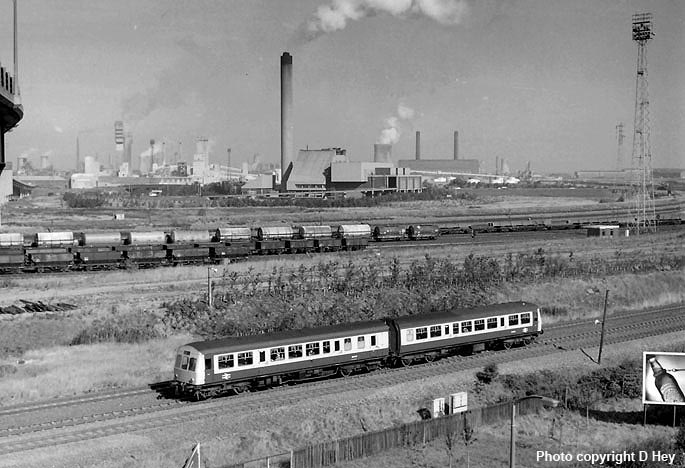
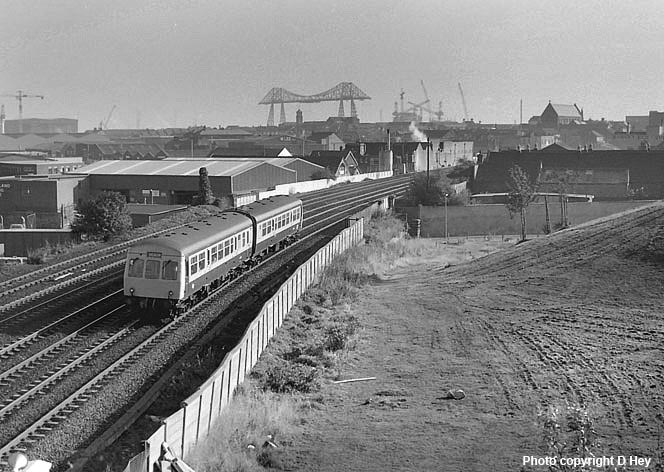
(Above-Below) A 2-car Metro-Cammel unit heads out of Middlesbrough on the same day as above. On the horizon is the famous Transporter Bridge across the River Tees, which carries the A178 Middlesbrough to Hartlepool road via Port Clarence on the north bank of the river. With an overall height of 225 feet, this spectacular bridge is a Grade 2 listed building and a familiar landmark for miles in all directions. Opened in October 1911 to replace the old steam ferry, the bridge carries a decking (gondola) suspended by steel cables for road vehicles and pedestrians. (Below) South Bank station is located 2½ miles east of Middlesbrough on the Tees Valley Line to Redcar; it was opened in July 1984 to replace Grangetown station a half a mile further east, which closed November 1991 to make way for a planned new dockside access road.
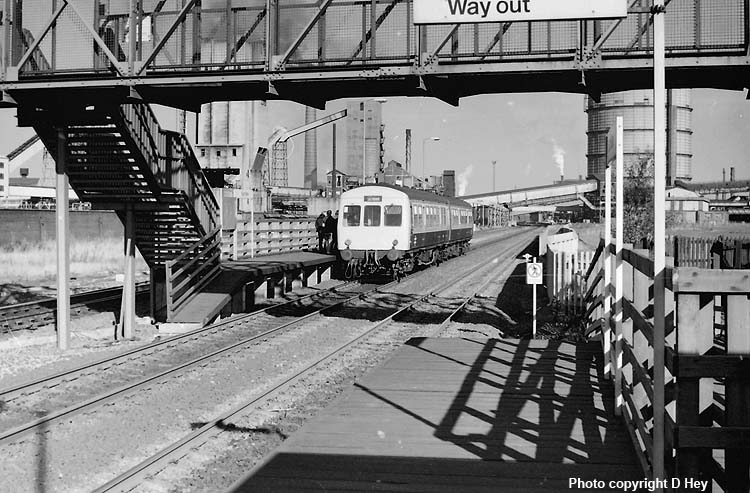
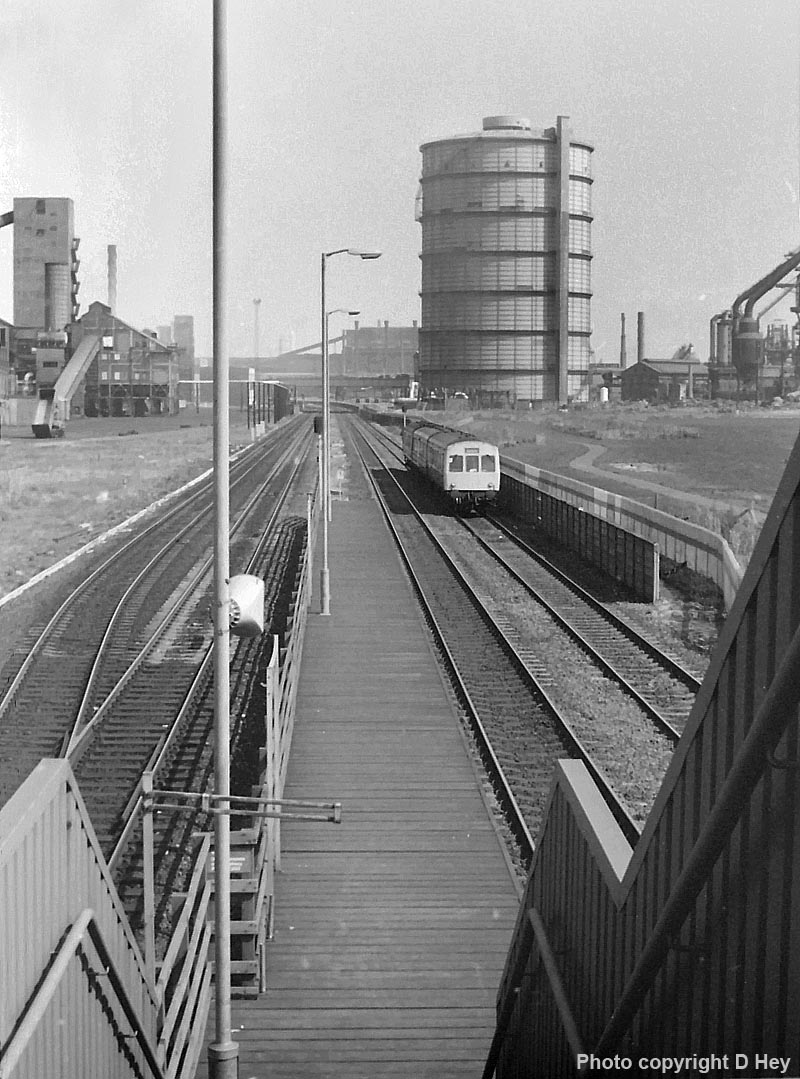
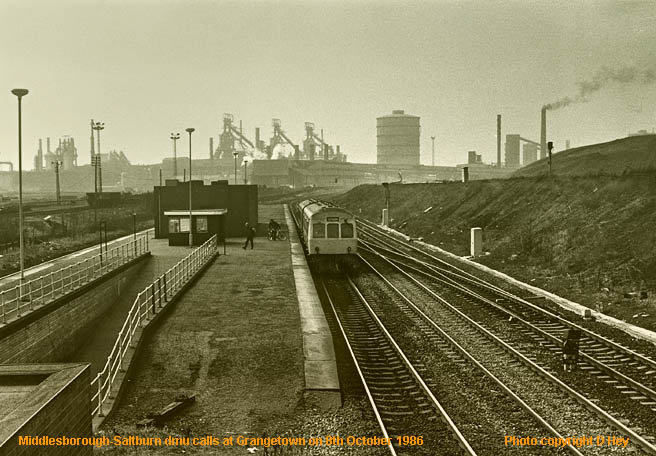
CUMBRIAN COAST LINE
(Above) Super-wide image of a 2-car Class 108 crossing Kent Viaduct on the the local Cumbrian Coast service...click on photo once, then again to see full-sized image.
YORKSHIRE AREA
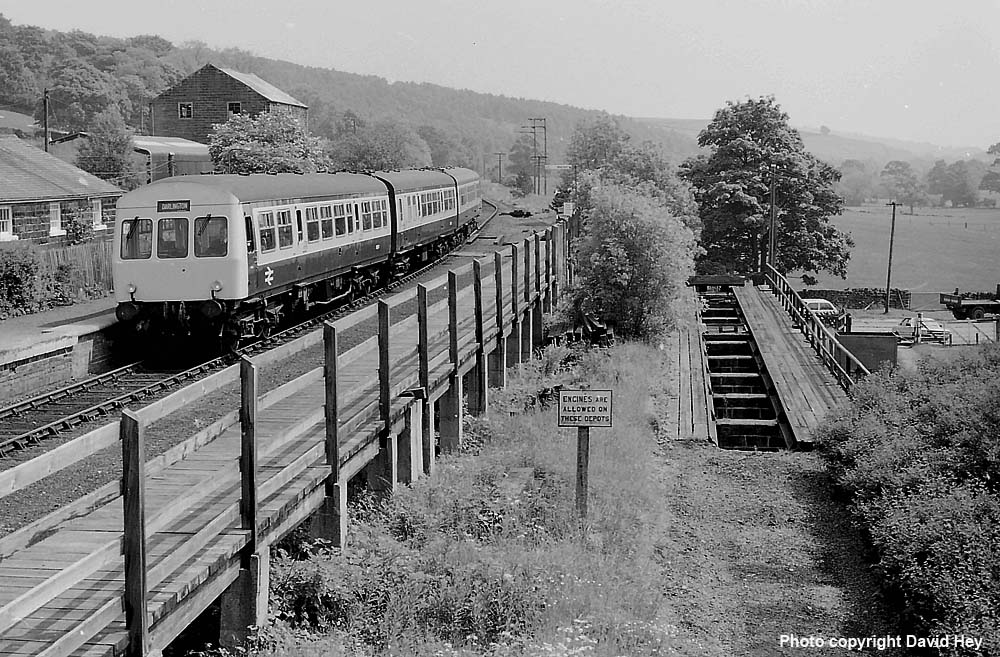
(Above-Below) The Eask Valley line...situated in the heart of some lovely North Yorkshire countryside is Castleton station, once terminus of the line from Picton on the Yarm-Northallerton route before the NER completed the section to Grosmont. The station was renamed Castleton Moor in 1965 and it has retained much of its charm - although the surviving notice in the middle foreground offers conemptuous odds for drivers on the derelict coal staithes. A Whitby-Middlesbrough dmu approaches the station in July 1983. (Below) One of the best-loved of English poets, Sir John Betjeman (1906-1984) would no doubt have something contemplative to say about these views of the rural branch line through the Esk Valley; the Poet Laureate was a great champion of British heritage and a staunch railway enthusiast, whose travelogue documentary 'Metro-Land' is widely regarded as a television masterpiece. In this view, a 2-car Metro-Cammell set from Whitby to Middlesborough approaches Glaisdale in July 1983. 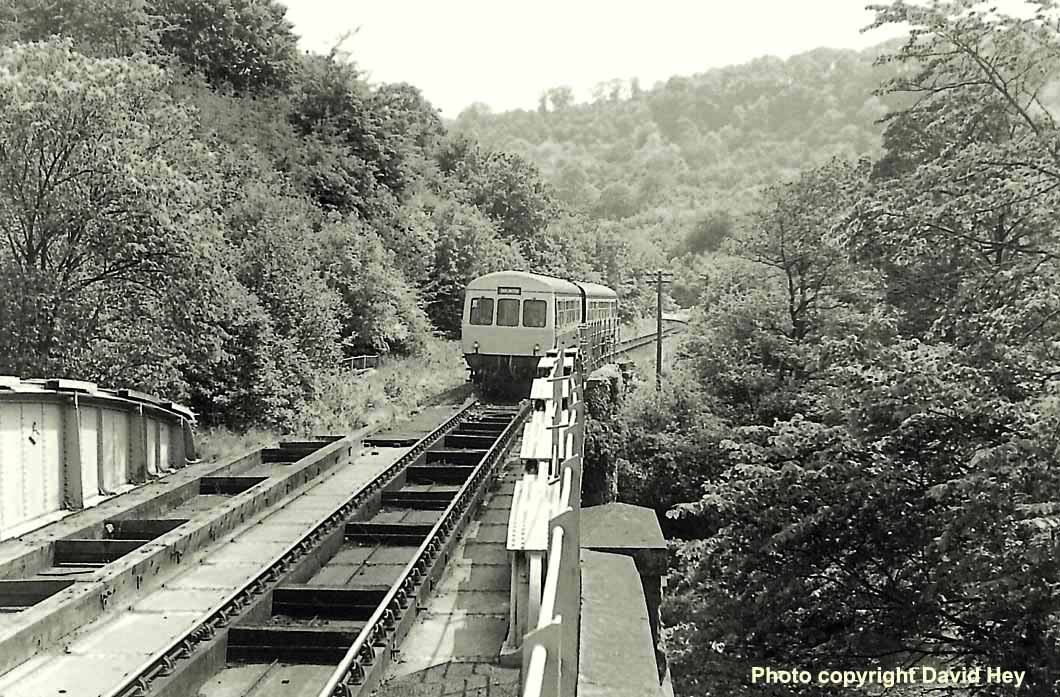

(Above-Below) A passing loop is provided at Glaisdale - one of two on the Esk Valley line - however the loop points are now worked automatically; the token machines for the single line block sections being operated by the train crew under the remote supervision of the signalman at Nunthorpe in Middlesborough; the box is responsible for the movements of all trains on the branch. (Below) Glaisdale's antiquated signal box on the Whitby-bound platform would doubtless call for a wistful commentary by Sir John Betjeman. 
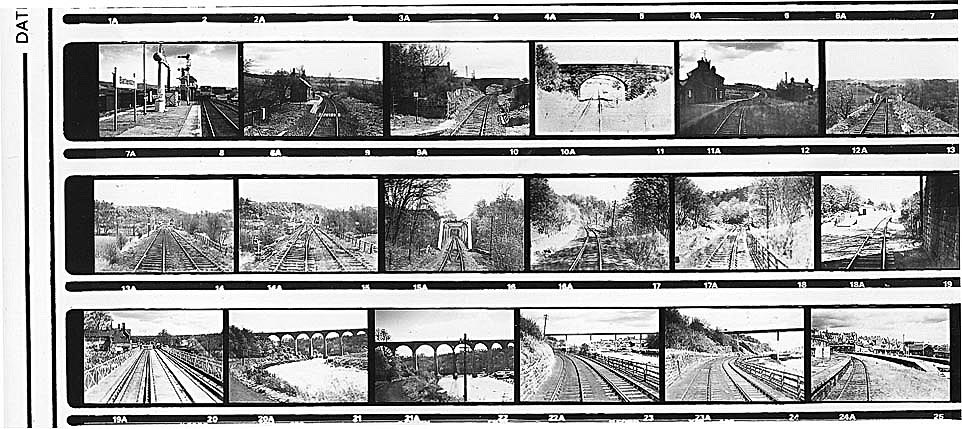
(Above) The new twin railbuses built by W Alexander/A Barclay replaced the ageing First Generation dmus on the line in 1985. Sadly, the good looks of the new vehicles were let down by their solid interior bulkheads behind the driver's cab which denied passengers both front and rear views over some of the most picturesque lines which BR was keen to promote. I was grateful to the driver of a Whitby-bound train for allowing me to accompany him in cab at Battersby…the contact sheet shows views of the journey to Whitby in August 1987.
(Below) Following an earthslip on the MR line at Royston in October 1982, the North East-South West service between Sheffield and York was diverted via Pontefract, whilst the service to Leeds was rerouted via Moorthorpe and Wakefield. Two years later, the Intercity sector of BR made significant changes to the service north of Sheffield by retaining the Leeds diversion, but rerouting York trains through Doncaster. Not only did it enable BR to save further expenditure on track and signalling to upgrade the MR route but it also provided an opportunity of focussing ECML and Humberside connections at Doncaster. This photo shows a Sheffield-Barnsley-Leeds dmu passing the once-numerous semaphores at Goosehill Junction, Normanton on 20th April 1982. The dmu has just crossed from the right hand pair of tracks from Wakefield Kirkgate. The lines on the left once formed the MR main line to Sheffield via Cudworth, but these were lifted in March 1988 during a major remodelling of trackwork at Goosehill Junction, which included the removal of semaphore signalling and the introduction of colour light MAS.
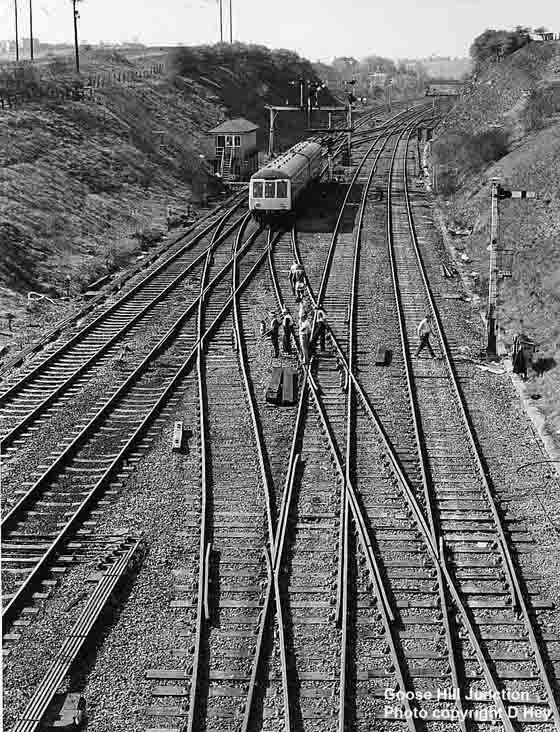
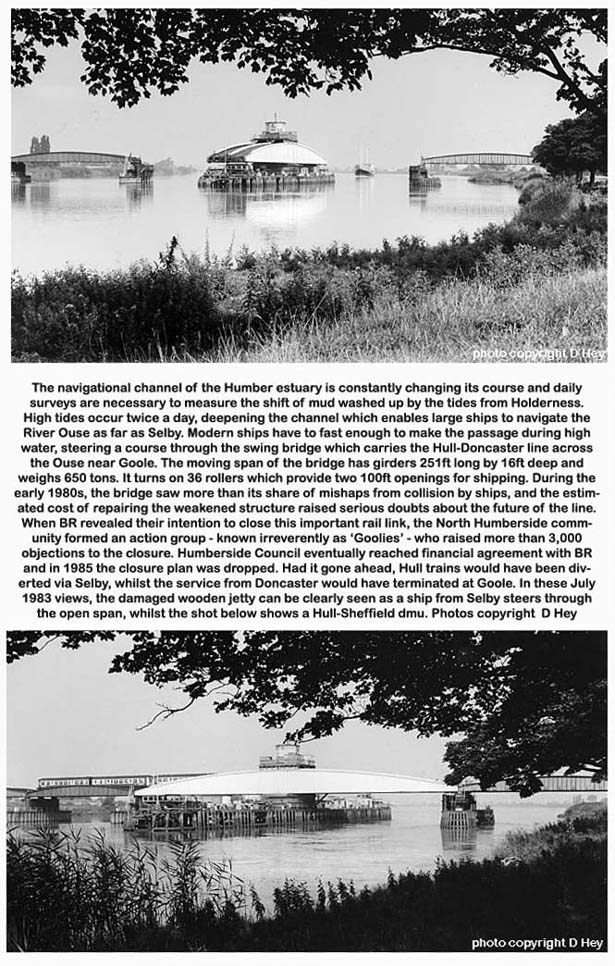 | 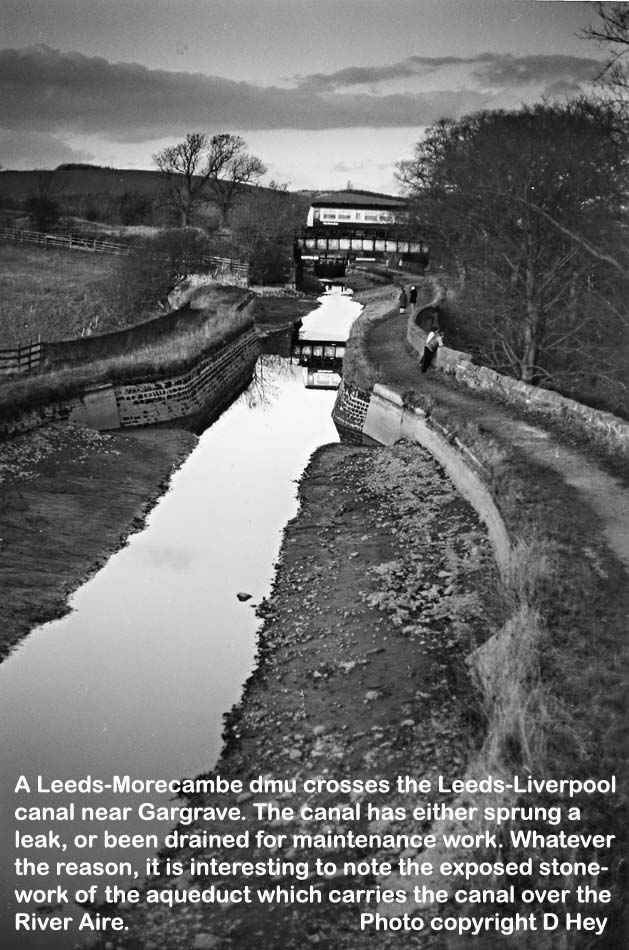 |
(Above-Below) Introduced in 1960, the Birmingham Railway & Carriage Co (TOPS Class 110) dmus were built for the steeply graded Calder Valley line across the Pennines. Two 6-cylinder engines powered the 3-car sets in order to gain the additional horsepower necessary to maintain the tight point-to-point schedules. By January 1962, the Leeds-Bradford-Manchester route was served by an hourly service with some trains running throughout between Harrogate and Liverpool. In this view of the upper reaches of Calderdale, a 3-car Calder valley set (forming the 13.58 Manchester-Leeds) descends from the 2,885 yard-long Summit Tunnel to Todmorden in July 1984. In the foreground is Gauxholme Viaduct, which carries the railway over the Rochdale Canal. The original turreted skew bridge consisted of a self-contained iron arch bridge that supported the deck system by means of hangers, but was reinforced with girders by the LMS in 1905.(Below) Another super-wide image of the Class 110, this time on the Standedge route...more details to follow.
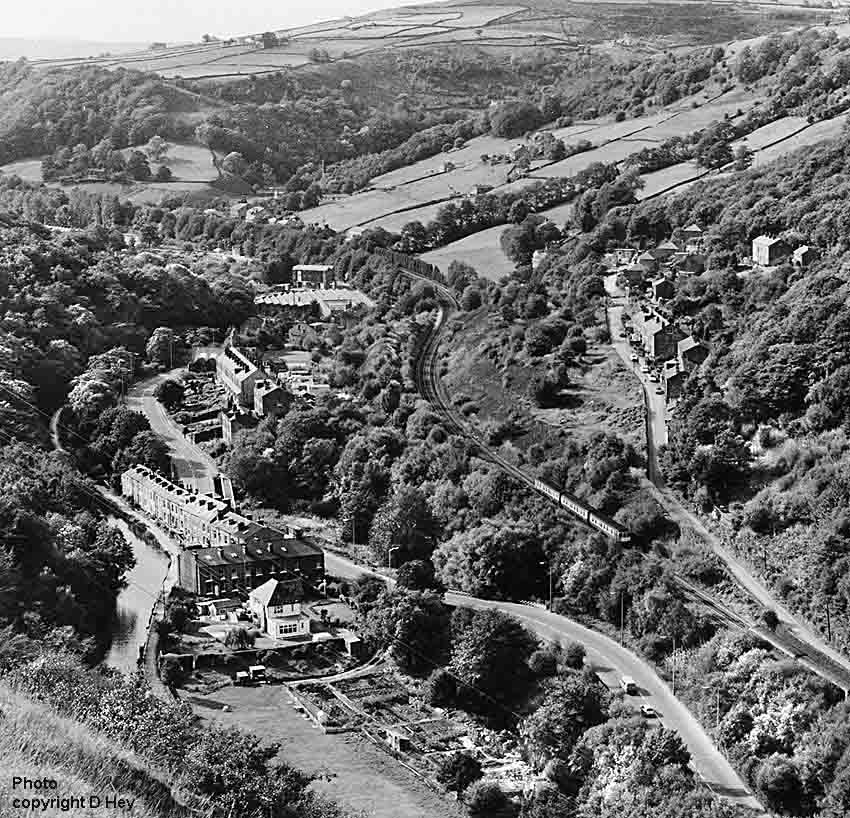
(Above-Below) A typical view of the Calder Valley, where the small town of Hebdon Bridge - 'The Pennine Centre' - is enclosed by steep hillsides. It is well worth the climb to enjoy the spectacular view of the river, road and canal winding through the valley. The shot graphically illustrates how well the railway blends into the landscape compared to say that of a motorway, which, with a minimum width of traffic lanes, hard shoulders and a central reservation would look truly awful in such a setting, let alone the intrusion of noise - one has only to witness the devastating effect that the M6 has had on the tranquillity of the Lune Valley in Cumbria. Here, a pair of Calder Valley units - one in each direction - is barely discernible amongst the trees. Out of all the Pennine rail links, only the Settle-Carlisle, Hope Valley line, Standedge and Calderdale routes have survived the Beeching era, which is more than can be said for the Waverley, Stainmore and Peak Forest routes.(Below) A 3-car set heads towards Sowerby Bridge in July 1984.

(Above-Below) In 1979, the Trans-Pennine service was restructured with hourly trains composed of air braked-electrically heated Mk2 coaching stock, and the elderly Class 124s were relegated to the south Trans-Pennine route from Hull to Manchester via Doncaster and Sheffield. A distinctive feature of the Trans-Pennine sets was the use of a glass-reinforced plastic for the wrap round windows on their driving car ends, seen here with Class 124s in both directions at Selby in July 1981.
(Below) In their final years the Trans-Pennine units were made up of original vehicles, later designated Class 124, together with Class 123s drafted from the WR. Mixed formations were regularly used, however the provision of gangway connections on Swindon's Class 123s gave them an altogether untidy appearance to the front ends. Framed by an aged semaphore, a 4-car set approaches Gilberdyke on August 1st 1983. Following rationalisation of the quadrified track between Melton and Gilberdyke, the slow line signals were removed and the subsequent imbalance on posts required considerable auxiliary guy-wire supports. Photos © D Hey
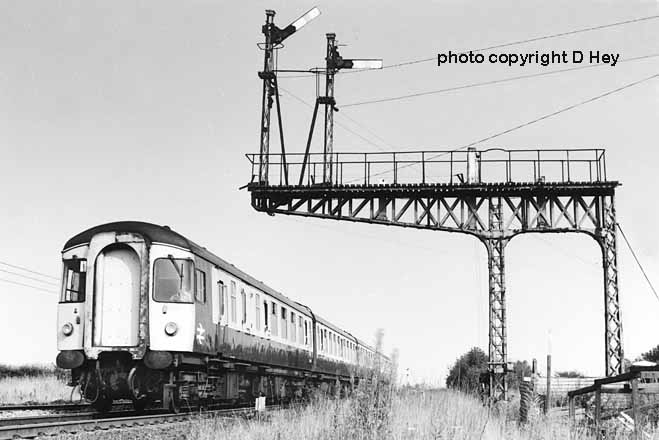

(Above-Below) In 1981, the decline of the Settle-Carlisle line as a major rail artery culminated with the rerouting of the scheduled Nottingham-Glasgow expresses via the Hope valley line leaving only a modicum of freight, together with two daily passenger services in each direction between Leeds and Carlisle. This clearly revealed BR's intentions to close the line, though it wasn't until 1983 that the rumour was confirmed. The inadequacies of the service attracted unfavourable attention, and BR introduced the elderly Trans-Pennine sets to provide a fast connecting service from West Yorkshire to west Scotland via the WCML at Lancaster. Here, the 10.35 Leeds-Morecambe accelerates from Settle junction in August 1983. Alas, in less than a year, having plied the arduous cross-country routes across the Pennines for a quarter of a century, the entire fleet was withdrawn in May 1984 and none have been preserved. (Below) A 3-car units climbs out of Bradford at St Dunstans on 31st May 1983. Photos © D Hey

Polite notice: All text and photographs are protected by copyright and reproduction is prohibited without the prior consent of the © owners. If you wish to discuss using the contents of this page the email address is below. Please note - this is not a 'clickable' mail-to link via Outlook Express. You will have to email manually.
dheycollection@ntlworld.com

